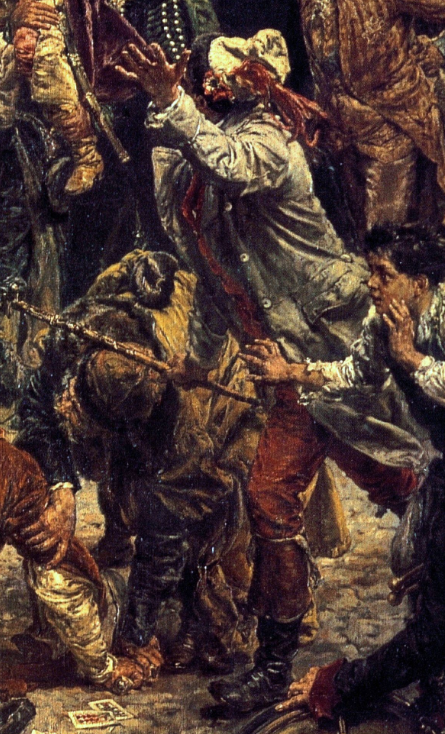Kazimierz Konopka on:
[Wikipedia]
[Google]
[Amazon]
 Kazimierz Konopka (1769–1805 or 1809) was a Polish Jacobin, secretary of Hugo Kołłątaj, officer in the Polish Legions, aide-de-camp of Jan Henryk Dąbrowski. He gained notoriety for his involvements in the unrest and hangings in Warsaw during the
Kazimierz Konopka (1769–1805 or 1809) was a Polish Jacobin, secretary of Hugo Kołłątaj, officer in the Polish Legions, aide-de-camp of Jan Henryk Dąbrowski. He gained notoriety for his involvements in the unrest and hangings in Warsaw during the
 Kazimierz Konopka (1769–1805 or 1809) was a Polish Jacobin, secretary of Hugo Kołłątaj, officer in the Polish Legions, aide-de-camp of Jan Henryk Dąbrowski. He gained notoriety for his involvements in the unrest and hangings in Warsaw during the
Kazimierz Konopka (1769–1805 or 1809) was a Polish Jacobin, secretary of Hugo Kołłątaj, officer in the Polish Legions, aide-de-camp of Jan Henryk Dąbrowski. He gained notoriety for his involvements in the unrest and hangings in Warsaw during the Kościuszko Uprising
The Kościuszko Uprising, also known as the Polish Uprising of 1794 and the Second Polish War, was an uprising against the Russian Empire and the Kingdom of Prussia led by Tadeusz Kościuszko in the Polish–Lithuanian Commonwealth and the Pr ...
.
Biography
Konopka was born in 1769 to a burgher family in Poznań. He studies law in Kraków, where he was a lawyer applicant in the F. Barss legal practice. Member of theKołłątaj's Forge
Kołłątaj's Forge ( pl, Kuźnica Kołłątajowska) was a group of social and political activists, publicists and writers from the period of the Great Sejm in the Polish–Lithuanian Commonwealth.
Centered on Hugo Kołłątaj, one of the most pro ...
organization and one of the Polish Jacobins, and secretary to Hugo Kołłątaj; during Kołlataj's period as the Deputy Crown Chancellor (podkanclerz koronny) in 1791, Konopka held the position of the Secretary of the Lesser Seal (sekretarz pieczęci mniejszej).
He participated in the Kościuszko Uprising
The Kościuszko Uprising, also known as the Polish Uprising of 1794 and the Second Polish War, was an uprising against the Russian Empire and the Kingdom of Prussia led by Tadeusz Kościuszko in the Polish–Lithuanian Commonwealth and the Pr ...
, joining the cavalry
Historically, cavalry (from the French word ''cavalerie'', itself derived from "cheval" meaning "horse") are soldiers or warriors who fight mounted on horseback. Cavalry were the most mobile of the combat arms, operating as light cavalry ...
. During that period, around May and June 1794, he gained notoriety as one of the leaders of the demonstrations and riots in Warsaw. In particular, he was involved in the "hanging of the traitors" incident around 28 June. In this incident, not supported by the insurrectionist government, out of several people hanged, including insurrection opponents such as chamberlain Karol Boscamp-Lasopolski, prince Antoni Stanisław Czetwertyński-Światopełk and bishop Ignacy Jakub Massalski, the defense attorney and a prosecutor who attempted to stop the mob were also beaten and hanged; they included a friend of Tadeusz Kościuszko, advocate Michał Wulfers.
For his involvement in the incident, Koponka was sentenced by the insurrectionist court to an exile
Exile is primarily penal expulsion from one's native country, and secondarily expatriation or prolonged absence from one's homeland under either the compulsion of circumstance or the rigors of some high purpose. Usually persons and peoples suf ...
(banicja).
Koponka left for France, where he joined French cavalry, and fought in Corsica
Corsica ( , Upper , Southern ; it, Corsica; ; french: Corse ; lij, Còrsega; sc, Còssiga) is an island in the Mediterranean Sea and one of the 18 regions of France. It is the fourth-largest island in the Mediterranean and lies southeast of ...
. In the aftermath of the final Third Partition of Poland, after Polish Legions were recreated under the French control in Italy, he became involved in the formation creation, reaching a rank of a captain
Captain is a title, an appellative for the commanding officer of a military unit; the supreme leader of a navy ship, merchant ship, aeroplane, spacecraft, or other vessel; or the commander of a port, fire or police department, election precinct, e ...
or major
Major (commandant in certain jurisdictions) is a military rank of commissioned officer status, with corresponding ranks existing in many military forces throughout the world. When used unhyphenated and in conjunction with no other indicators ...
(sources vary). He commanded a squadron, and later, a baon. In 1801 he was an aide-de-camp of Jan Henryk Dąbrowski.
He died in 1805 in Bari
Bari ( , ; nap, label= Barese, Bare ; lat, Barium) is the capital city of the Metropolitan City of Bari and of the Apulia region, on the Adriatic Sea, southern Italy. It is the second most important economic centre of mainland Southern Italy a ...
(Pachoński mentions a sudden heart attack) or in 1809 (according to Rusinowa).
Konopka is one of the figures immortalized in Jan Matejko
Jan Alojzy Matejko (; also known as Jan Mateyko; 24 June 1838 – 1 November 1893) was a Poles, Polish painting, painter, a leading 19th-century exponent of history painting, known for depicting nodal events from Polish history. His works includ ...
's 1891 painting, '' Constitution of 3 May 1791.'' He is shown near the center, with an outstretched hand, holding the czekan (an ax- and hammer-like weapon) and with a French blue-white-red flower in his hat.
References
{{DEFAULTSORT:Konopka, Kazimierz 1769 births 1805 deaths Kościuszko insurgents Polish legionnaires (Napoleonic period) Military personnel of the Polish–Lithuanian Commonwealth Lawyers from Warsaw Military personnel from Poznań Polish Jacobins